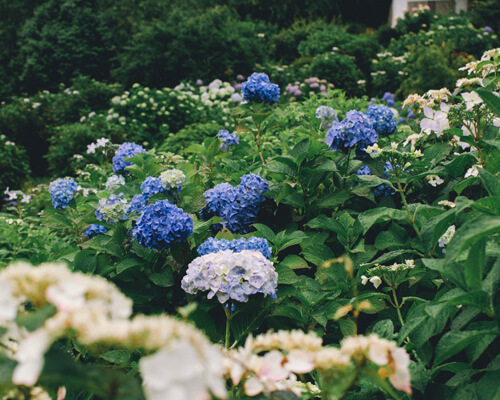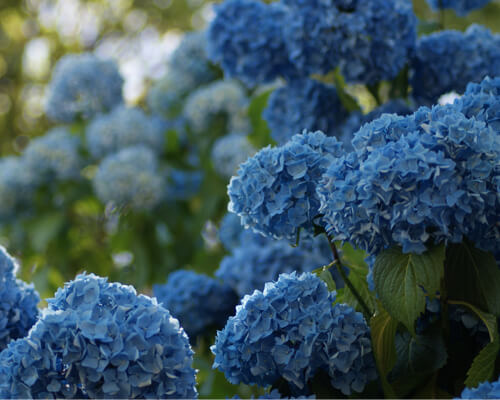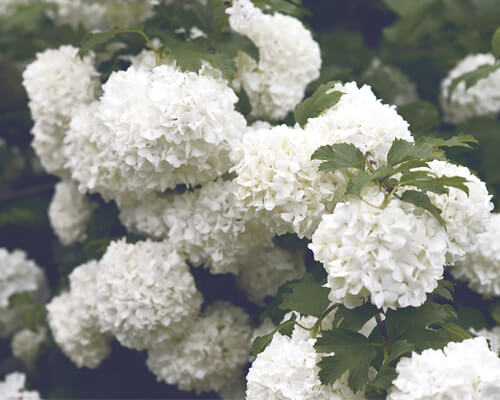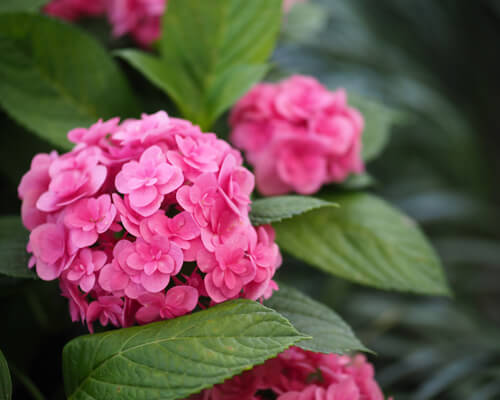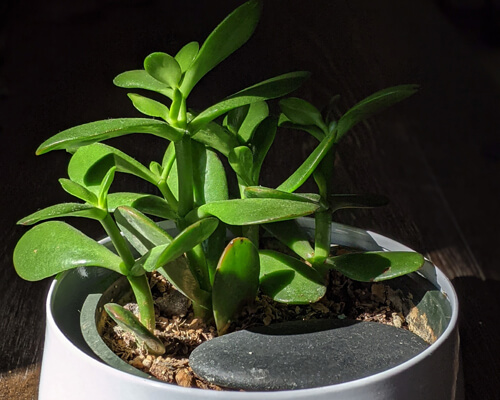How to Fertilize Hydrangeas?
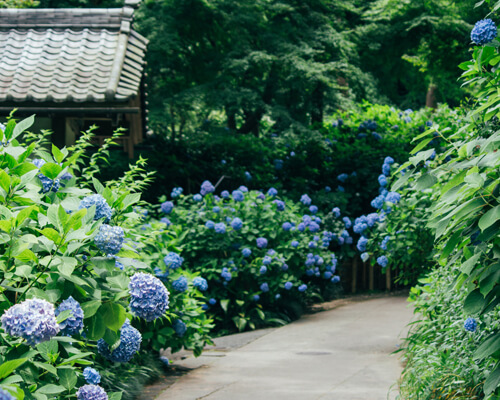
How to fertilize hydrangeas? Hydrangeas are beautiful flowering plants that require adequate fertilization to thrive.
The type of fertilizer used entirely depends on the specific hydrangea being grown, as well as the soil conditions.
Hydrangeas need phosphorus to promote strong root development, and potassium to help the plant tolerate stress.
An improper balance of these nutrients can lead to stunted growth or poor flowering.
With a careful understanding of the type of hydrangea, its soil composition, and fertilizing techniques, producing beautiful and healthy hydrangea plants is achievable.
When to fertilize hydrangeas
When fertilizing hydrangeas, it is important to apply the fertilizer during the flowering period of the season.
In spring, as soon as the first signs of growth start to emerge, including new buds and leaves. You should fertilize your hydrangeas with a fast-release fertilizer.
This provides the plants with an early-season boost and will help ensure that they get off to a good start for the growing season.
Additionally, you should fertilize again mid-way through summer (usually around July) with another fast-release fertilizer application.
This allows for continued growth throughout the Summer months, while also providing additional nutrients that may be necessary for healthy blooms.
It’s important to note that too much fertilizer can cause problems such as slowed growth and poor flower production.
So it is best to follow instructions on any product labels carefully.
Furthermore, water deeply after applying fertilizer to ensure that it gets absorbed deep into the root zone and isn’t lost due to surface evaporation or runoff.
Following these simple steps, you can provide your hydrangeas with all of the nutrients they need in order to thrive.
Types of Fertilizers for Hydrangeas
To ensure your hydrangeas thrive, they require regular fertilization.
Different types of fertilizer can be used to provide essential nutrients and maintain optimal growth for your hydrangeas.
Liquid Fertilizer
Liquid fertilizer is an ideal option for those who want quick results with minimal effort.
It is easy to apply and typically provides a richer nutritional value than granules or spikes.
The advantage of liquid fertilizer is that it can be spread over a wide area and quickly absorbed into the soil, providing fast-acting nutrients for your hydrangeas.
Liquid fertilizers also allow gardeners to customize their nutrient needs by mixing different formulations together as needed.
Additionally, liquid fertilizers are often less messy than other types, making them convenient to use around delicate plants like hydrangeas.
Granular Fertilizer
Granular fertilizers come in solid form and must be mixed into the soil before planting or applied topically after planting has been done.
This type of fertilizer contains slow-release nutrients which slowly seep into the soil over time. Giving your plants a steady stream of essential elements for long-term growth and health benefits.
Granular fertilizers are generally more cost-effective than liquid varieties.
Although they might require more effort when initially incorporating them into the soil before planting or when reapplying them during the growing season.
Spikes
Spikes are specialized forms of fertilizer designed specifically to nourish plants at their root level.
They contain high concentrations of nutrients.
As they break down in the soil over time, they are gradually released through small holes in their surface.
Spike is great for those who want to provide their plants with long-term nutrition while avoiding frequent reapplications.
In addition, spikes provide nutrients directly to the roots from below.
They, therefore, help prevent leaves from becoming oversaturated with too much water or other environmental hazards.
These hazards may damage the leaves or stems of the plant if apply topically liquid fertilizer.
Organic vs. Inorganic Fertilizers
Organic
This type of fertilizer is popular among gardeners due to its natural composition, which makes them safer to use.
They are made of organic components. Such as compost, animal waste, seaweed extracts, and plant by-products.
Natural sources of nutrients can improve the soil condition, making it more porous and able to hold more water.
The organic matter also helps promote beneficial microorganisms in the soil. It can help release minerals for the plants’ nutrition over time.
Organic fertilizers tend to be slow-release. Meaning they will provide your hydrangeas with a steady supply of nutrients over time.
In addition, these fertilizers contain very low amounts of nitrogen and other essential nutrients like phosphorus and potassium.
These nutrients are essential for a healthy start for your hydrangeas.
Inorganic
Inorganic fertilizers offer a higher concentration of nutrients than organic fertilizers. So you might not need as much for each application.
They usually contain concentrated synthetic forms of nitrogen, phosphorus, and potassium to ensure fast growth in plants and encourage blooming.
Inorganic fertilizers are often applied in small amounts and can provide quick results compared to their organic counterparts.
However, overuse may lead to nutrient imbalances or even toxic levels of chemicals in the soil.
On the bright side, they tend to last longer in the soil than organic fertilizers.
So if you are looking for a longer-term solution to your hydrangea’s nutritional needs, there is no need to reapply as often.
How to choose?
When choosing between organic or inorganic fertilizers for your hydrangeas. It is important to consider what type of soil they are growing in. How much maintenance is required from you as a gardener?
If your soil is naturally rich enough with a good balance of minerals, then using an organic fertilizer may be enough.
However, if your soil lacks essential minerals or requires more frequent applications due to its structure, better to use inorganic fertilizer.
Whichever type you choose, it is important to read the label instructions carefully before applying the fertilizer.
This is to avoid burning or otherwise damaging your hydrangea due to excessive nutrient levels or inadequate nutrient distribution throughout the root growth area.
Fertilizing to change bloom color
Fertilizing to change bloom color is a great way to experiment with the colors of your hydrangea flowers.
Adding aluminum sulfate to make blue flower sepals bluer and garden lime to make pink flower sepals pinker is a popular trick that many gardeners enjoy.
However, when trying this method, it is important to take certain precautions for the health of your plant.
One key step in changing the bloom colors of your hydrangeas through fertilization is timing.
If you add amendments to your soil before the blooming season, either in late fall or early spring, you can achieve the best results.
Adding these at other times could cause damage or inhibit blooming due to nutrient imbalances.
Furthermore, be sure not to overdo it on the fertilizer. Too much can easily burn and damage your plants.
When fertilizing for bloom color changes, it’s also important not to forget about other nutrients that are essential for healthy hydrangeas. Such as nitrogen, phosphorus, and potassium.
Choose a balanced fertilizer blend containing all three of these nutrients. So that all elements necessary for strong and vibrant growth are available.
Alternatively, look into using organic options like compost or natural manure. As they have a much lower risk of burning or damaging your plant compared to synthetic chemical fertilizers.
Finally, keep an eye on your hydrangea while you’re experimenting with changing colors and adjust accordingly if it doesn’t seem happy with its new environment.
That way, you can ensure a healthy plant with beautiful blooms that will last for many years.
How to fertilize hydrangeas?
For most varieties of hydrangea, a slow-release chemical fertilizer should be applied once a year.
The best time to do this is in the spring and early fall.
When you are ready to fertilize, spread the fertilizer at the drip line of the branches, not the base, and lightly cover it with soil to activate it.
Water well after fertilizing, as this will help ensure that your shrub gets the full benefits from its nutrient boost.
In addition to applying these more general fertilizers, consider adding some other nutrients to your hydrangea’s diet that could help enhance their growth and aesthetic qualities.
For example, if you’re looking for larger blooms on your hydrangea bush, add an extra dose of phosphorous in March and May.
If you want an especially vibrant shade of blue flowers, use an iron supplement around mid-summer.
Be sure not to overdo it though as too much nitrogen could result in more leaves and longer stems than expected with fewer flower heads growing in comparison.
Lastly, remember that hydrangeas absorb nutrients from both their roots and foliage throughout the season so make sure to take caution when watering too.
Too much water or too much fertilizer may cause damage and burn the leaves which are not ideal for vibrant blooms in the end.
Keep an eye on your plant’s health and adjust accordingly throughout the season for optimal results with your fertilizer routine.
Conclusion
Fertilizing hydrangeas is an essential step to having healthier, more vibrant plants.
Regular fertilization will help make sure your hydrangeas have strong root systems and can better handle stresses like droughts and harsh temperatures.
It’s important to apply the right fertilizer according to each plant’s needs, taking into account their specific species, size, and growing conditions.
When selecting a fertilizer, use one that has low nitrogen since too much can limit blooms or cause stunted growth.
Finally, always water the fertilizer in a well with a bucket of lukewarm water for the best results.
With the proper care and proper fertilization from this blog post article’s instructions, you will experience greater success with your hydrangeas in no time.

